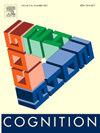聋哑人可以在没有成人语言模型的情况下创造语音学和音系的基础
IF 2.8
1区 心理学
Q1 PSYCHOLOGY, EXPERIMENTAL
引用次数: 0
摘要
然而,暴露于最小语言输入的儿童可以在形态学、句法和语义层面上将语言特征引入他们的交流系统(Goldin-Meadow, 2003a)。然而,他们是否能在语音和音系水平上做到这一点尚不清楚。这项研究的问题是,先天失聪的儿童,无法学习口语,生活在一个没有接触过手语的听力健全的家庭,是否将音韵学和语音学引入了他们创造的称为家庭符号的手势交流系统。我们关注的是语音学和音系学的两个基本属性——形式的离散性,这是独立于意义定义的,从而形成了模式的二元性的基础。我们研究了失聪儿童的食指和张开的手掌形状以及他们的听力母亲的共同语言手势。我们发现指示手势中的手型在家庭手势中比在同语手势中更离散。此外,在共同言语手势中,离散程度取决于意义(象征与指示),而在家庭手势中则不是。因此,即使没有这种特征的模型,孩子们也可以在他们的家庭符号系统中创造独立于意义的离散形式。这一发现有助于解释为什么这种语言特征在口语和手语中是普遍存在的。本文章由计算机程序翻译,如有差异,请以英文原文为准。
Deaf homesigners can create the foundations of phonetics and phonology without an adult linguistic model
Children who are exposed to minimal linguistic input can nevertheless introduce linguistic features into their communication systems at the level of morphology, syntax, and semantics (Goldin-Meadow, 2003a). However, it is not clear whether they can do so at the level of phonetics and phonology. This study asks whether congenitally deaf children, unable to learn spoken language and living in a hearing family without exposure to sign language, introduce phonology and phonetics into the gestural communication systems they create, called homesigns. We focused on two foundational properties of phonetics and phonology––discreteness of forms, which is defined independently of meaning and thus forms the basis of duality of patterning. We examined index finger and open flat handshapes in deaf children's homesigns and their hearing mothers' co-speech gestures. We found that handshapes in deictic gestures were more discrete in homesign than in co-speech gesture. Moreover, the degree of discreteness depended on meaning (emblems vs. deictics) in co-speech gesture, but not in homesign. Children can thus create discrete forms that are meaning-independent in their homesign systems even without a model for this feature. This finding helps explain why this feature of language is universal in spoken and signed languages.
求助全文
通过发布文献求助,成功后即可免费获取论文全文。
去求助
来源期刊

Cognition
PSYCHOLOGY, EXPERIMENTAL-
CiteScore
6.40
自引率
5.90%
发文量
283
期刊介绍:
Cognition is an international journal that publishes theoretical and experimental papers on the study of the mind. It covers a wide variety of subjects concerning all the different aspects of cognition, ranging from biological and experimental studies to formal analysis. Contributions from the fields of psychology, neuroscience, linguistics, computer science, mathematics, ethology and philosophy are welcome in this journal provided that they have some bearing on the functioning of the mind. In addition, the journal serves as a forum for discussion of social and political aspects of cognitive science.
 求助内容:
求助内容: 应助结果提醒方式:
应助结果提醒方式:


